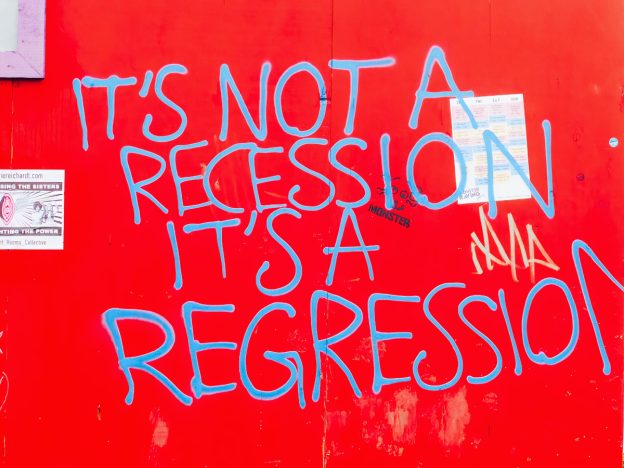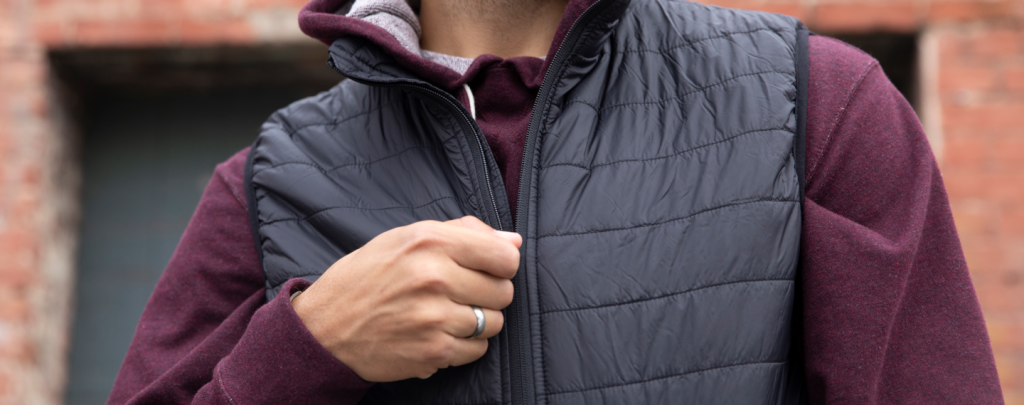

You’ve probably heard a lot of talk about recession lately and the possibility of impending doom and gloom for worldwide markets. To be honest, the last thing we want to be doing is fear mongering, so if that’s what you are looking for, you aren’t in the right place. This article is to help with some practical advice for how to think about your clothing line during a recession and some simple things that you can do to drive sales, build brand, and take care of customers while the world crumbles around you (just kidding).
It’s worth noting that the powers that be, are saying we aren’t in a recession (yet) and we may not enter a recession for the foreseeable future. With that in mind, these strategies can still be employed in great times, but when cash is tight, or you haven’t figured out how to consistently get sales for your clothing line.
What Is A Recession And Why You Should Care?
A recession is a prolonged period (think months or years) of economic downturn across multiple industries. For business this can mean slower sales, for employees it can mean layoffs, unemployment or cuts in scheduled hours. Generally, not good things. For all the nerds in the audience, key economic indicators of a recession are slower or negative GDP growth, high inflation rates, and increased unemployment. (As an individual with an economics degree, I’ve been waiting 20 years to put it to good use). 🤣
When have your own clothing line, getting sales in the door is one of the most challenging endeavors you will face, ultimately, being in a recession will not make it any easier to get sales. The sad reality is that it will likely be harder. But with this in mind, there are some basic strategies to follow in creating and selling products that can help you maneuver through tricky markets and come out the recession stronger than ever before.
How A Recession Changes Consumer Buying Habits
The biggest direct impact a recession will have on your clothing line is changes to consumer buying habits. Unfortunately, it will affect consumers in different socio-economic situation differently, but understanding who you are selling to and how they are behaving will help you create and position products that fit well into their mental purchasing framework.
- Essentials – People in lower socio-economic groups will begin to only purchase items deemed as essential, things like; food, clothes, and shelter. They will attempt to find cheaper solutions for these basic goods as well.
- Treats – These little perks are things that make consumers feel good and while lower socio economic shoppers may avoid these treats, mid and high end socio economic shoppers will still indulge, but may do so less frequently.
- Bigger purchases – While selling your apparel directly to consumers would not typically be considered “bigger purchases,” selling your line to boutiques, events, or department stores would certainly be considered a bigger purchase. During a recession, bigger purchase tend to be delayed due to uncertainty of economic conditions.
Here Is Some Sound Financial Advice For Challenging Economic Conditions
We all have heard the phrase “cash is king,” and in challenging economic times it rings more true than ever. Here’s why; having cash on hand gives you the ability to pay bills, salaries, and make investments in your business as you see fit. When cash gets tight it forces you to stop making investments that you otherwise would make in and limits your ability to grow. If you run out of cash, you will likely end up having to shut down your line altogether. With these thoughts in mind, let’s outline some key strategies you can use to ensure your clothing line can create cashflow for you to continue to operate and grow your clothing line.

3 Strategies To Use To Create Cashflow For Your Clothing Line
Don’t Invest In Inventory Where You Don’t Have To
To the extent you can, use on demand manufacturing. Whether your call it print on demand, or dropshipping, you must take advantage of this approach to supply chain planning in order to keep your balance sheet as clean of inventory as possible. When you use traditional bulk or mass production approaches to manufacturing there is always an upward pressure on MOQ (minimum order quantity) to secure the best possible cost of goods sold and profit margin. However, in challenging economic times it’s a better bet to sacrifice profitability for free cashflow.
Print On Demand allows you to make micro inventory investments (think $15 – $30 for a single sample) and your time to market the product, in order to start selling it and generating cashflow. And that is what Print On Demand does better than anything else; it turns micro investments into free cashflow. Each time you make a sale, it’s money going directly into your bank account. Keep in mind, you still have to pay your print on demand vendor, but in general each sale should be making your bank account go up, up, up, and that’s exactly what you want to happen.
A Special Note For Screen Printing Pure-ists: How to explain the difference between DTG & Screen printing to end customers
While we love screen printing too, it may not be the best time to use this type of manufacturing to deliver your products because it requires your upfront investment of cash. However, if your customer base is expecting screen printing based on previous products you’ve made, there are a few approaches that you can use to set good expectations for a brief transition to using direct to garment printing (required for producing items on demand). The best way to reset expectations is to clearly explain on your product pages that these product are being made on demand, and will have results similar to screen printing with water based inks. Another great way to explain differences is to position these products as distressed or vintage prints. Finally, we strongly recommend using artwork that is well suited for DTG (millions of colors & graphic realism) as opposed to traditional screen printing artwork (limited colors).
If you absolutely cannot pull your brand away from screen printing, you may want to consider pre-selling items (take the orders and payment upfront), then getting the exact quantities you need to produce, and produce only those items. This will ensure you don’t end up with excess inventory that is tying up your cash during challenging economic times.

Don’t Slash Marketing Budgets, Invest Wisely
While it’s tempting to indiscriminately slash your marketing budgets to preserve precious cash, most experts don’t recommend this approach. Instead, it’s best to shift your marketing investments to things that you know work well for your brand, and perhaps cut back on other “general purpose” marketing initiatives. In order to identify marketing initiatives that work well for your brand it’s important to look at the ROI that can be tied to that exact marketing activity.
For online direct to consumer fashion brands, the high ROI staples are typically: email marketing, paid search, social media, & SEO. If you are currently using these any of these marketing channels successfully, now is a great time to think long and hard about how you can use them more extensively or even better than you ever had before. The good news is, this new focus will be a lasting gain for your business which you can continue to use in times of good economic conditions as well.
The Most Valuable Overlooked eCommerce Marketing Channel
Ok, this is gonna sounds super old-school, but did you actually send an email to your customers about that new launch you did? eMail continues to be the most tried and true driver of revenue and it’s just so difficult to consistently drive sales without using email. The return on investment for email marketing is easily 10x for most brand and can be as high as 100X if you are really doing it well. If you haven’t taken the time to setup your email marketing platform, just do it now. No really, stop reading and just do it now.
Ok now that you have set up your email marketing tools make sure you have automated ways to get email addresses from your website. If you aren’t asking website visitors for email addresses, stop reading now and get it setup. Once you have a steady flow of emails coming into your email marketing platform, don’t be shy about staying in touch with your list and letting them know what’s going on with your brand, designs you are working on, or where you need their help.
Position Your Products To Align With New Consumer Sentiments
Knowing your customers is always the key to unlocking wins within your clothing line. Aside from tapping into consumer sentiments with your apparel designs you should also be sure to position products in a light that reflects the sentiments of your various consumer groups.
For example, if you are positioning your clothing line to fulfill the essential needs of every human to put a shirt on your back, it’s most wise to focus on that benefit and making the shirts as affordable as possible. However, going this route may not leave much room for profit. So it maybe wiser to position your goods not as an essential item, but instead as a treat, something that can make the consumer feel good about their situation.
On the other hand, if you are already positioning your brand and products for higher socio-economic consumers, it’s likely they have the assets to weather an economic downturn and you should expect major shifts in their overall buying patterns. Instead, it maybe best make more sense to focus on the limited nature of your products, the impacts your brand makes in a larger community, or building a strong tie to the lifestyle your consumers identify with. For these customers, it maybe best in to invest in a free pack ins which will surprise and delight customers and re-enforce future purchase decisions.
How To Turn Excess Inventory Into Quick Ca$h
The traditional retail approach to the problem is clear, simple, and effective. Mark down the products with deep discounts to clear out the inventory and free up the capital so you can re-invest into products that will sell (hopefully at higher margins).
Here’s the problem with markdowns
However, in many cases, the brands that retailers are marking down isn’t their own brand, it’s someone else’s brand. And that is something you want to keep in mind. Intentionally setting a steep discount on your branded products, could reduce consumer confidence in those products, or even worse your brand for a long time.
Investments that don’t cost money and will move product
So while mark downs seems to be the most simple and straightforward, I would not overlook more creative ways to move product. If you’ve stocked up on a bunch of inventory that isn’t exactly flying off the shelf, now is the time to start getting creative. I recommend starting with a quick assessment of the marketing assets you’ve put together for the product to ensure you have made the basic marketing investments to help support the product selling through. A few very cost effective assets that you can create are lifestyle photos (make sure to put them on your product page), a quick video about the product (think of a tik tok, reel, or short), and last but not least a great product description. For the product description, don’t just describe the product, tell a quick story about how the product came about or tell a story about how you envision your customer using the product.

How to “up fit” existing eCommerce inventory to create new products
If some styles you are carrying have minimal branding or artwork, consider using them as a base and find cheap & effective ways to add branding or artwork to them to create new products.
For example, you can simply add an embroidered or woven patch to your favorite (but slow selling) blank hat to make it into a fun new product.
If you have 250 t shirts that you’ve screen printed, consider sewing a golden neck label into 75 of them to make a limited edition of the shirt that sells for $5 more.
These simple strategies to make existing products more special can net you some big short term gains in converting otherwise “stuck” inventory into much needed cash.
Here’s one more great example, if you have 50 black hoodies with a print on the front, setup a mini dyes station and splash them with a small amount of bleach to transform the batch into a custom splash dyed hoodie collection. Customer’s will appreciate the hand-made aspect to the garment, the fact that each one is unique. Last but not least, bleach is cheap, so it’s a super cost effective way to give an old look a new feel. Many of these “up fitting” activities are also an opportunity to create content or tell a story about the product.

When Times Are Tough Make Sure To Work Together
If times are tricky for your clothing line or business, I find that the feeling can be isolating for the brand owner. It’s hard to talk about, discuss, and bring up. I know some owners feel a tinge of shame or uneasiness, like they are somehow to blame for their line not doing as well as they would hope. It’s best to set aside these feelings immediately. You need to be open and communicative about the state of your business and remember this, it’s not just you that is in this situation. It is highly likely that other people and brands are facing similar challenges as you. By talking about it with your peers, you can commiserate on bad times, and they may have some small tips for things that have worked for them to drum up sales. Whatever you do, don’t keep the state of affairs a secret, make sure to air it out with people you trust and respect.
Lastly, don’t overlook that a downturn in market conditions can create new market opportunities for your brand. For example, it maybe harder for a certain artist you’ve wanted to work with to get their work out there, and now they maybe more open to partnering up with your clothing line. Another example, is that a notable influencer in your industry may lose a top value sponsorship, and now you have an opportunity to build a relationship where you never had the opportunity before. You have to remember that when one door is closed, there is usually still a window open (if not many windows). Do not overlook economic downturns as great time periods to forge new partnerships that can become the foundation of future growth.
The 3 absolute most important pieces of advice about thriving through a recession
Never give up, remain positive and active, and communicate with your stakeholders. By doing these things you will stay resilient and nimble you’re sure to weather economic downturns.

 Recent Posts
Recent Posts